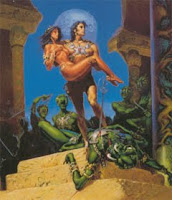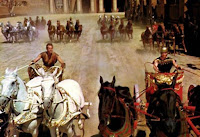Category: Rubin
May 18, 2012 / 2 Comments
Textbook Storytelling
December 9, 2011 / 3 Comments
Counting the Minutes
February 25, 2011 / 3 Comments
Previously on SPLICED
If you don’t get this week’s title, don’t worry. No one does. One of those lost gems of animation.
Anyway, last week was all about linear structure, so this week I wanted to explain narrative structure. Linear structure is all about the characters, but narrative structure is about the audience, be they readers or listeners or movie-goers.
By the way…
Try to remember that. It’s going to be important.
I mentioned last week that a story always needs a beginning, a middle, and an end. However, they don’t always need to come in that order. Ex-Heroes and the upcoming Ex-Patriots each have almost a dozen major flashbacks to a period before the beginning of each respective novel.  A Princess of Mars begins with the frame story of Edgar Rice Burroughs inheriting a manuscript from his recently-deceased uncle, John Carter, and the film Inception starts with the frame of a battered and ragged Cobb washing up on the shore of an old man’s private island. Clive Barker’s Sacrament dives into an extended flashback that dominates the middle of the book, as does the classic film Casablanca. Everyone remembers Quentin Tarantino’s Pulp Fiction for its wonderful non-linear story and he also loaded the Kill Bill movies with flashbacks. Heck, the film Memento actually runs its story backwards.
A Princess of Mars begins with the frame story of Edgar Rice Burroughs inheriting a manuscript from his recently-deceased uncle, John Carter, and the film Inception starts with the frame of a battered and ragged Cobb washing up on the shore of an old man’s private island. Clive Barker’s Sacrament dives into an extended flashback that dominates the middle of the book, as does the classic film Casablanca. Everyone remembers Quentin Tarantino’s Pulp Fiction for its wonderful non-linear story and he also loaded the Kill Bill movies with flashbacks. Heck, the film Memento actually runs its story backwards.
By the way, don’t get confused by my talk of linear structure and non-linear stories. You can still get french fries even though you’re not in France, and you still need linear structure even though you’re telling a non-linear story.
Now, there are some important things to remember with narrative structure.
First off, if narrative structure and linear structure aren’t going to match up in a story, there should be a real reason why the story’s being told that way. Is there no way this information could come out except in a flashback? Is there a purpose to cutting back and forth between past, present, and future? Is this structure advancing the story or bogging it down with unnecessary segues?
There was a passable Denzel Washington movie a while back called Fallen. In all fairness, it was a great movie that got dragged down because the lead actor kept doing a Denzel Washington impression through the whole thing. I’m about to spoil the ending, so if you haven’t seen it and have any interest… skip down a paragraph or two.
Fallen begins with Denzel in his death throes. He’s thrashing around in the snow and clawing the air. His voice over tells us (paraphrasing a bit)…
“Lemme tell you about the time I almost died. Actually let me start a little before that…”
At which point the film leaps back in time about a week to Detective Denzel attending the execution of a serial killer. A serial killer who, it turns out, is actually possessed by a demon. And by the end of the film, said demon has possessed Denzel. The frame sets up the audience for a twist— it hasn’t been the detective narrating, and it wasn’t him dying. It’s the demon, trapped by the detective’s final act. Without the frame, there’s no twist.
In my book, Ex-Heroes, every third or fourth chapter is a flashback. This serves two purposes. One, since it’s already a shift in the narrative, it also let me shift the viewpoint to first person. It also lets me tell another aspect of the story. While the main plot of Ex-Heroes is about living in the aftermath of a zombie apocalypse, it’s also important to know how this all came about. So shifting into the past let me develop a few key characters and it let me see some important events through their eyes.
A bit more on that next week.
The narrative also has to be readable. That sounds kind of common-sense, I know, but one problem that crops up a lot is writers taking that non-linear inch and running a few miles with it. Since I can go a bit non-linear, I can push the envelope and go a little more, and then a little more, and then…
Remember that sentence up above I told you to remember? Do you know what it means? Well, it’s not a sentence, it’s just the alphabet out of order. But it kind of looks like a sentence, and I’m willing to bet a few of you spent a moment trying to decode it (is it backwards writing? Serbian? Roman numerals?) without much luck.
Y’see, Timmy, there comes a point when a writer has broken up the narrative with so many flashbacks, recollections, and frames-within-frames that they’ve just got gibberish. Oh, sure, if you spent twenty minutes or so studying that first example you would’ve all eventually figured out it was the alphabet. I don’t doubt that at all. The same could be said about any number of non-linear books or screenplays. Given enough time, a spreadsheet program, and a bottle of rum, most of us can make sense of just about any story.
But no one wants to read a story like that. I don’t think any of you read this ongoing series of rants with the hope that someday you’ll understand what I’m talking about. You read it because you want to understand something now, not for me to show off by giving you an incomprehensible puzzle of verbs and nouns to work out over the next week or so. So while it’s okay to mix a story up a bit, at the end of the day your audience has to be able to follow the story. Flashbacks and frames are great, but, like so many things, need to be used responsibly and with moderation.
I got to interview Bruce Joel Rubin, an Academy Award-winning screenwriter, a while back. During our talk, he made the keen observation that stories, especially film stories, are experienced through the gut, not through the mind. The moment your audience has to go into their head to understand a story–you’ve lost them. It shatters the flow and brings them out of experiencing the story and into, on some level, analyzing it. So the last thing you want is so many non-linear elements that the reader has to stop for each one and figure out how it relates to the last twenty or thirty.
And really, this is what I’m going to talk about next week. Linear and narrative structure need to work together, not fight each other.
So, until then, go write something.
September 25, 2009 / 2 Comments
Secrets of the Order
I have been prodded to remind folks the Amazon link off there on the side has grown again. So… go hit the link.
What about that title? Sounds impressive, eh? Alas, the order we’re talking about is a bit more mundane. It’s not much of a secret, either, now that I think of it.
Well, too late now. You’re already reading. Let’s move on.
Structure, unbelievable as it may sound, is how your story is put together. It’s the underlying shape and order that everything else hangs on. If you don’t have structure, all you have is a pile. Even something as amazing as the Guggenheim still follows a lot of the basics of building construction.
Much like the physical architecture of buildings, there are certain rules a writer needs to follow with the structure of their story. And, much like with architecture, ignoring these rules often means the story will collapse. Or end up so unsightly nobody will want anything to do with it.
There are two types of story structure I want to rant about. One is linear structure. The other is dramatic structure. They’re two separate things that should tie together if you’re doing things correctly, in the same way that dialogue and character should tie together. Hopefully we’ll have time and space here for both.
So, first up, here’s a pop quiz. What does this mean?
Mqnw berctx yzuai sopdl fkgjh.
No clue? What if I put it like this…?
Ghijkl abcdef mnopqrs wxyz tuv.
A little easier for some of you to see the pattern? Yes and no? Okay, try this…?
Abcdefg hijklmnop qrstuv wxyz.
Ahhhh, well now it’s obvious, isn’t it?
I mentioned a while back that three act structure always needs a beginning, a middle, and an end. However, they don’t always need to come in that order. A Princess of Mars begins with the frame story of Edgar Rice Burroughs inheriting a manuscript from his recently-deceased uncle, John Carter. The film The Prestige has a wonderful, interwoven, double-frame structure of a prisoner awaiting execution and reading the journal of his supposed victim, a man who had stolen the prisoner’s journal and is relating what he discovers as he studies it. My upcoming novel, Ex-Heroes, has almost a dozen major flashbacks in it to a period before the beginning of the novel. And, of course, everyone remembers Pulp Fiction for its wonderful non-linear story.
One easy way you can check a story to make sure all these tricks work is to cut it up and put the bits in chronological order, like a timetable. This is the order the characters and the world are experiencing the story (as opposed to the reader). Does effect still follow cause? Are the actions and dialogue still motivated? If it starts to get fuzzy or questionable, that’s not a good sign.
The other problem here is some people have taken that non-linear inch and run a few kilometers with it (mixed metaphor intentional). Since I can go a little bit non-linear, I can push the envelope and go a little more, and a little more, and a little… Well, the first example shows the problem with this. There comes a point when the narrative has been broken up with so many flashbacks, recollections, and frames-within-frames that you’ve just got gibberish.
Oh, sure, if you spent twenty minutes or so studying that first example you would’ve eventually figured out it was all the letters of the alphabet. I don’t doubt that at all. The same could be said about any number of non-linear books or screenplays. Given enough time, a spreadsheet program, and a bottle of rum, most of us can make sense of just about any story.
Thing is, Timmy, I doubt many of you read this collection of rants with the hope that someday you’ll understand what I’m talking about. You read it because you want to understand something now, not for me to show off by giving you an incomprehensible puzzle of verbs and nouns and clauses to work out over the next week or so.
Of course, all audiences feel this way. So while it’s okay to mix a story up a bit, at the end of the day your reader has to be able to follow the story. Flashbacks and frames are great, but, like so many things, need to be used responsibly and with moderation. Bruce Joel Rubin, the Academy Award-winning screenwriter of Ghost, recently made the keen observation that stories, especially film stories, are experienced through the gut, not through the mind. The moment your audience has to go into their head to understand the story–you’ve lost them. It shatters the flow and brings them out of experiencing the story and into, on some level, analyzing it. So the last thing you want is so many non-linear elements that the reader has to stop for each one and figure out how it relates to the last twenty or thirty.
This is also a good time to mention this little oft-occurring problem…
Abcdefghijklm456nopqrstuvwxyz.
The thing that immediately sticks out is the element that has no business being there. In the midst of our flowing, structured story (the alphabet) the 456 is something that ties to nothing before or after it and has no bearing on anything else in the story. It is, to use a previous example, the speech about Masada in that early scene of Raiders of the Lost Ark. Depending on the story, the 456 may be a clue for stories yet to come, a really cool dance/ action/ comedy sequence, or something none of here can even imagine, but if it isn’t really part of the story then… it shouldn’t be in the story.
Hmmmmm… this isn’t huge, but I think if I continue with dramatic structure this is going to get kind of sprawling. So let’s call this good for now while it’s still readable.
Next week, I’ll continue my mindless rant about structure with a discussion of drama and kayaking.
Until then, go write.



